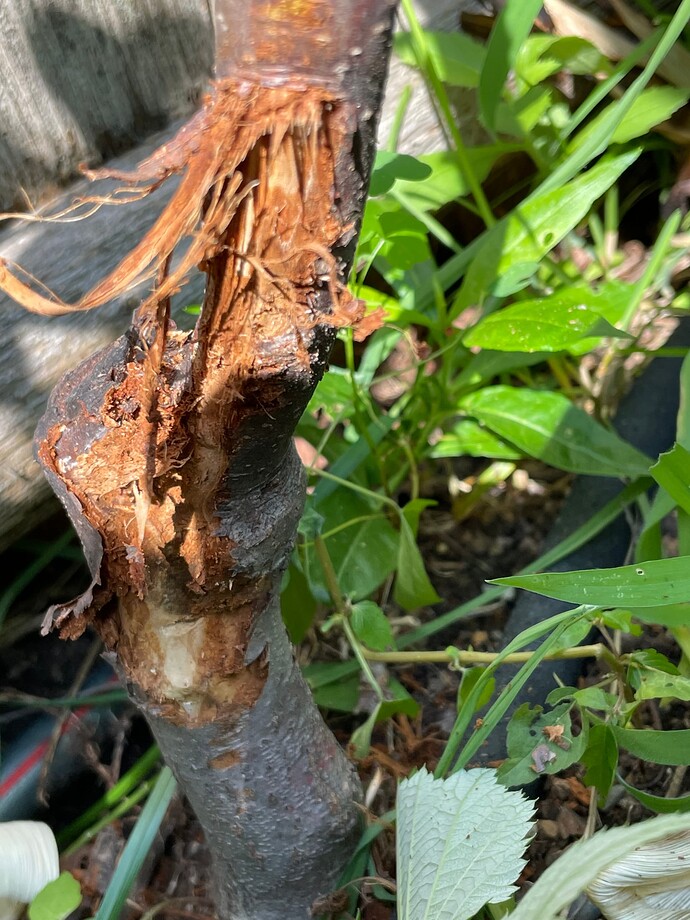This is an espalier. The top cordon is wilted but not the bottom.
Usually with apple and pear if part of the tree is affected and another isn’t it’s fireblight.
I just checked again. The entire tree is affected .The tree right next to it is not affected.
Is it too late to treat?
What should I treat it with?
In that case you need to prune off all infected wood and destroy it to prevent spread to others
Can you stop fire blight?
Monitor trees regularly, and remove and destroy fire blight infections. (See Removing Diseased Wood.) If fire blight has been a problem in the past, apply blossom sprays. Sprays prevent new infections but won’t eliminate wood infections; these must be pruned out.
Dennis
Kent, wa
Pruning off all infected wood would mean removing all cordons and possibly the trunk below the bottom cordon, leaving only a small stump of scion wood. Or removing the entire tree. Please tell me there is a way of avoiding doing this.
How old is this tree?
Likely there are some latent buds below the bottom cordon that would emerge and grow if the infection has not reached them! But the longer you wait the more it spreads, so here is where a quick decision might save something.
You might consider regranting with a variety more resistant if you have or can locate scions.
Apples are easily grafted this late in the season.
Dennis
@DennisD Thank you for your suggestions. Am I correct in assuming that the rootstock might also be infected?
Not necessarily but if you do not cut about 6” below all infected areas it will spread to the rootstock
All of the scion is infected. How can I tell if the rootstock is also infected, in which case I will have to remove the entire tree.
Hi Vlad,
I do not know since the foliage reaction is all you have to determine the answer. If all of your foliage is curling to brown? Then your options are:
- Remove the entire tree if this is your only good planting site this option controls spread into the soil!
- If you have alternative good planting sites for a new tree, then you could cut the rootstock back to about 6” above the soil and let it put out new growth. That new growth if healthy will answer your question and give you a chance to reutilize that rootstock, in which case you want to select a resistant variety to graft. Apples are readily grafted until mid August. If you do this option try to water it well and fertilize to boost the speed of recovery.
Good luck
Dennis
@DennisD I am somewhat confused by your post. I do not have an alternate planting site.
So, do I remove the tree and plant another in its place?
Or do I cut it back to 6" above the soil and graft another variety onto it?
I scraped the bark of the rootstock and scion and am enclosing a photo of what I found. Looks like at least part of the rootstock and scion are dead.
Now what do I do?
Remove, burn whole rootstock! Or dispose of your property in a place away from apple growers.
I would not reuse this hole for a year or so!
Act quickly to avoid spread to others!
Dennis
Vlad,
From the look of your damage trunk, would that be what caused the wilting and poor condition of that tree, not fire blight?
Something took a big chunk of that tree.
The trunk did not appear to be damaged before I scraped it. The damage you see was caused by me scraping the bark looking for green cambium, which I did not find.
Could it be that it was not fireblight after all unless the blight infection reached down into the rootstock? The roots were dark brown with no white rootlets. Looks like root rot, but is it?
@DennisD Thank you so much for your advice. I Googled and found a number of articles saying that it is OK to plant in same hole because Erwinia, the fireblight pathogen, does not survive in soil. Any comments?
No I’m no expert on it, just know what others say about it


